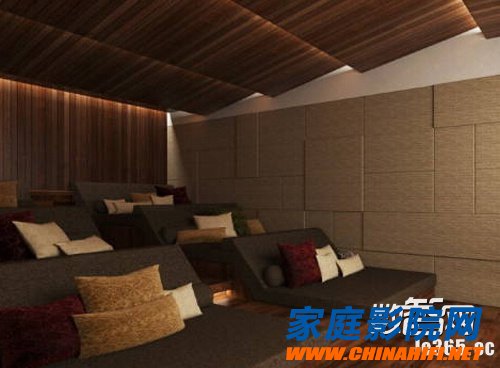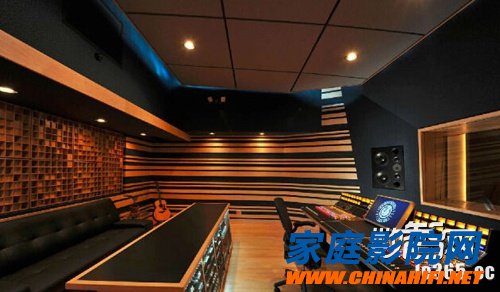Small space acoustic design is a large category in architectural acoustic design. The small space mainly includes space with high acoustic requirements such as recording studio, piano room, home theater, and small professional mixing room. Due to its small space, the law of sound propagation in it is significantly different from that of theaters and other professional viewing spaces. Small spaces are prone to cause acoustic defects such as standing waves, vibrating echoes, and acoustic dyeing.

Small space, as the name implies, refers to a room with a relatively small indoor space. The room size is generally 3-5m, and the size is slightly larger to about 10m. Its acoustic design mainly includes reverberation time control and indoor sound field control. Due to the small size of the room in the small space, there is a certain proportional relationship with the wavelength of the acoustic wave, especially in the low frequency part below 200 Hz. Therefore, the inherent resonance mode of the small room causes the sound energy attenuation of a certain frequency band to be different from the normal attenuation process, or the resonance frequency is concentrated in a certain frequency band, causing the sound dyeing phenomenon, so that certain frequency components of the sound are greatly enhanced, thereby causing the original There is distortion of the tone or a tinting effect.
The best reverberation time for each hall
It is worth noting that reverberation time is an important measure of indoor sound quality, and different rooms require different reverberation times. Therefore, materials with different sound absorption characteristics should be selected for reasonable matching to control the flatness (response) of the indoor reverberation time curve. In a small space, if the reverberation time is too long, it is easy to cause the indoor sound tail to be too long and ambiguous. For the room used for mixing, the above problems will seriously affect the quality of the mix.
Small space indoor acoustic index requirements
According to the requirements of small space use, the acoustic indicators are not the same. For example, in the mixing room, the acoustic index requires that the background noise meets the NR-20 curve requirement, and the reverberation time generally requires 0.4±0.1S. Moreover, qualified room acoustic design must require the elimination of acoustic defects such as standing waves, chattering echoes, and acoustic staining.

Difficulties in acoustic design of small space buildings
It is well known that acoustic defects such as standing waves, comb filtering, resonance, and degeneracy are easily generated in a small space of a rule, so that certain frequency components of the sound are greatly enhanced, resulting in distortion of the original tone or a dyeing effect.
Small space indoor acoustic treatment
In order to avoid the above acoustic defects, the design and material selection can be consciously adjusted during the indoor acoustic design phase. The adjustment mainly includes the following methods: changing the indoor body shape and rationally arranging the decoration materials with different sound absorption characteristics in the room.
1, the choice of indoor body proportion
In order to avoid the occurrence of the above acoustic defects, it can be known from the foregoing that a regular body shape easily causes acoustic defects indoors. In particular, the ratio of the length, width, and height of the space is an integer ratio. Therefore, at the beginning of the space design, the ratio of length, width and height can be adjusted when determining the size of the indoor space. The ideal ratio of length to width is 1:21/2:21/3, and it is often difficult to meet the ideal ratio for architectural design conditions.
2, indoor diffusion treatment
In order to eliminate the acoustic defects that may occur in the room, the method of adding a diffuser inside the space may be adopted, and the variation of the convexity and concave on the wall surface is used to uniformly distribute the room mode to achieve a smooth low frequency response and improve the indoor sound field. Common practices for diffusion structures include:

1) Set the inclined wall surface to change the regular shape of the room, change the direction of propagation of the indoor sound reflected by the wall surface, and thus change the vibration mode of the indoor sound field. However, this method causes the shape of the interior to be irregular, especially in the room, which is not suitable for indoors, such as furniture and decorative items, reducing the effective indoor use area and reducing the indoor use efficiency. Moreover, the low-frequency sound energy is easily concentrated in the acute angle portion, resulting in a new sound field distribution uneven.
2) Set the diffuser on the wall. The diffuser can use a simple flap shape or a circular arc shape to scatter the sound energy incident on the surface of the diffuser, and can also improve the sound field in the room. This can be combined with the design of the decoration to avoid acoustic traces.
In the process of setting up the sound field in a small space, the decoration design and acoustic design should be combined, the diffusion method should be selected according to local conditions, and the acoustic design should be included in the decoration design to ensure the aesthetic requirements.
3, indoor sound absorption treatment
Reverberation time control in a small space is another important aspect of acoustic design, and different usage spaces require different reverberation time metrics. The general mixing room requires a shorter reverberation time, which is conducive to the formation of an excellent indoor sound field by the electroacoustic system, especially the well-groomed effect. Commonly used sound absorbing materials can be divided into thin plate resonance sound absorbing materials, which are mainly used for resonance absorption of low frequency parts; representative materials are such as gypsum board and wood splint.
Sound insulation room
Sound insulation design for space enclosures and slabs is the basic means to ensure a low background noise in the room. Another purpose of sound insulation is to prevent indoor sounds from affecting the outside world. When the indoor background noise requirements meet the NR-20 curve requirements and the room is located in a common civil building, the sound insulation of the wall is generally required to reach 60 dB. If there is a high noise and vibration source around the location of the space or a place like a dance hall, the sound insulation of the wall should be higher, that is, the multi-layer composite structure should be used, combined with the sound insulation ceiling and floating ground. The indoor space is treated with overall sound insulation.
Home Theater Network Summary: The acoustic design of small spaces involves architectural design, sound quality design, sound insulation design and vibration isolation design. Good sound quality design is the result of close cooperation between various professions. Moreover, the acoustic design requirements should be provided to the architectural design and air-conditioning HVAC professional as early as possible, and relevant considerations and conditions should be reserved in advance. At the same time, everyone needs to pay attention to the fact that the acoustic effect must match the decoration design, not only requires good indoor sound quality, but also must have beautiful visual effects, to create a good acoustic audio-visual environment and comfortable home environment.
solar &wind hybrid street lighting system have prominent advantages of compact design, energy saving and self-powering. In this system, wind turbine are complemented by solar power in supplying power for Led Lamp, as to its hybrid characteristics, which could provide a balance.It's advantages is that if rainy days,cannot use the sun power,then the wind power can work instead.It applies to the place where wind power is strong.
Solar Wind Hybrid Street Light
Solar Wind Hybrid Street Light,Hybrid Solar Street Light,Wind Solar Street Light
Yangzhou Beyond Solar Energy Co.,Ltd. , https://www.ckbsolar.com